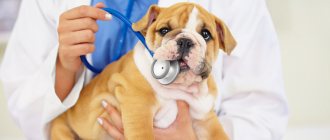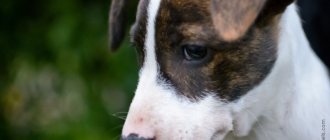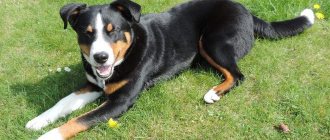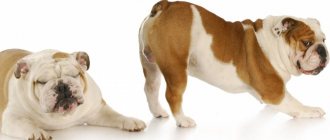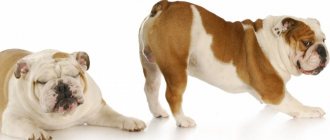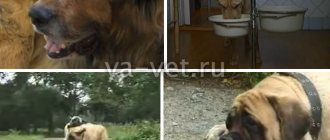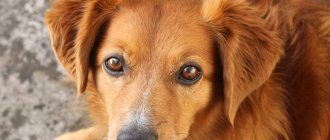A head injury poses a threat to your pet's life. A concussion in a dog can occur even as a result of a minor mechanical impact on the head. Every owner should be informed about the characteristic symptoms, as well as what to do about it. In some cases, the life of a pet is at stake, so it is very important to provide him with correct and timely assistance.
Concussion in a dog
A concussion in a dog is a serious pathological condition that provokes disruption of the vestibular apparatus, changes in behavior and poor health of the pet. Even a minor skull injury requires examination at a veterinary clinic. The owner himself will not always be able to compare the cause and effect of the injury, especially since the symptoms may not appear immediately or be nonspecific.
Etiological factors: why pathology occurs
The cause of the disease is any factor that has a mechanical effect on the animal’s skull. It could be:
- Road accident.
- Hitting with a stick, stone.
- Gunshot wounds.
- Falls from heights.
In dogs of small (decorative) breeds (Chihuahuas, toy terriers, etc.), a concussion can occur even if an unsuccessful fall from a sofa, jumping from hands or, during active play, “slamming” with a running start into any hard object (wall, radiator, tree, etc.).
Important! It is strictly forbidden to hit a pet on the head, give a “slap on the head” in case of unworthy behavior or as a punishment. An insignificant, in a person’s opinion, physical impact provokes a severe concussion and sad consequences, even death.
Central vestibular syndrome
External manifestations (imbalance) of central vestibular syndrome may be similar to peripheral vestibular syndrome, but this disease affects parts of the brain - the pons, medulla oblongata, and vestibular nuclei. A neurological examination reveals disorders of the cranial nerves, depression of consciousness, decreased conscious positioning reactions on the affected side, nystagmus can be vertical. Such animals always need additional diagnostic methods - first of all, neuroimaging (MRI).
With rare exceptions, many of the common causes of central vestibular syndrome can lead to progressive worsening of neurological symptoms and even death if left untreated.
Causes of central vestibular syndrome: arachnoid cysts, malformations of the caudal (posterior) part of the occipital bone, hydrocephalus, neoplasms in the brain stem - primary and metastatic, infectious and inflammatory diseases (meningoencephalitis, which can be caused by infectious agents - bacteria, viruses, fungi and protozoan organisms, and have an autoimmune nature), brain stem injuries.
Treatment and prognosis for different diseases are different; the final diagnosis, as a rule, requires a large number of additional studies, but a thorough neurological examination can provide the doctor with important information confirming or refuting some suspicions. In case of vestibular symptoms, it is important to promptly contact a qualified doctor - a specialist in the field of neurology, because diseases requiring different treatment differ only in minor nuances during examination and history taking.
The main signs of a concussion: what you need to pay attention to
A concussion in a dog is accompanied by the following clinical signs:
- Impaired movement coordination. Walking in circles, unsteady gait, sudden, fearful jumps, causeless aggression.
- Lethargy, apathy, anorexia (refusal to feed).
- Rapid pulse (up to 150 beats/min.).
- The pet does not respond to the owner's calls.
- Periodic vomiting.
- Ophthalmological problems (tremor of the eyeballs, different pupil sizes, fear of light, unfocused gaze).
- Trembling of the limbs, when outwardly it resembles convulsions, paralysis, paresis (the dog cannot stand or walk).
- Involuntary urination and defecation.
- Change in color of visible mucous membranes.
The animal makes characteristic movements with its mouth, as if swallowing air. Sometimes it can “grab” people standing nearby with its teeth, but such movements are unconscious. Therefore, you need to secure the mouth with a muzzle and a bandage.
Symptoms of a concussion include headache and loss of consciousness, either periodically or some time after the injury. With severe damage to the brain and the centers responsible for the functioning of vital organs, respiratory paralysis, cardiac arrest and death can occur.
Important! A distinctive feature of the symptoms of a concussion in a dog is the frequency of their occurrence over significant periods of time. Signs of pathology may appear after several hours or days. Therefore, if there is a skull injury, you need to show your pet to a veterinarian without waiting for clinical signs of illness to appear.
So:
- If an animal falls on its paws, there is a high probability of violation of the integrity of the pelvic bones, fractures and dislocations of the limbs.
- When falling on the stomach or side, pneumothorax often develops, rib fractures, rupture of the spleen, and blunt extensive injuries to internal organs occur.
- The most dangerous injuries when falling on your back are spinal fractures and skull bruises.
It is better not to drag a damaged animal to another place or turn it over. Before the specialist arrives, it is necessary to clear the oral cavity of dirt and mucus, and ensure a position in which the dog’s muzzle is slightly lower than the limbs (to improve blood flow to the brain). Also, if possible, place ice or any very cold object on your pet's head.
[custom_ads_shortcode3]
Memo to the owner: what to do
If a head injury occurs or characteristic symptoms of a concussion appear, the owner should not ignore them or try to treat the dog themselves. Giving any medications is prohibited. It is important to understand that long-term consequences are even more severe than the primary ones, which develop in the first 30 minutes. after brain damage. Therefore, you should not put off a visit to the veterinary clinic, citing lack of time, the hospital itself in a residential area, or other reasons. The owner must understand that “it won’t go away on its own,” and some damage can be effectively eliminated in the first hours and without consequences.
Procedure for fainting or fainting:
- Call a veterinarian.
- The dog is placed on its side, its mouth is opened slightly, the tongue is hung on its side to prevent its involuntary retraction and suffocation.
- Remove all ammunition and clothing.
- Apply a hypothermic bag or a cold item wrapped in cloth (meat from the freezer) to your head.
If it is impossible to call a specialist, the dog is carefully placed on a flat surface (plywood), trying to prevent the head from shaking, hanging down, or hitting. In this form they are delivered to a veterinary clinic for examination and treatment.
First aid
If your dog has a concussion, it definitely needs help. To do this, perform the following steps:
- You need to remove the dog's collar, muzzle, and everything that may hinder its movements and breathing.
- Place it on its side on a flat, hard surface.
- Remove the tongue so that if she loses consciousness, she cannot choke or suffocate on it.
- Check pulse and breathing.
- Apply a cold compress to your head (you can use an ice pack).
- Seek veterinary help.
If your dog has been hit by a car, or has additional injuries, especially fractures and open wounds, you should try to call an emergency veterinarian or a doctor at home.
Diagnostics: what they do in the veterinary clinic
The veterinarian must determine the severity of the damage and the changes that have occurred in the brain. For this purpose they prescribe:
- X-ray. The image allows you to exclude/confirm fractures of the skull vault, fragments, and displacement of the cervical vertebrae.
- CT, MRI. It is possible to assess the degree of damage to brain tissue.
- Consultation with an ophthalmologist, neurologist.
You cannot refuse an examination; this is the only way to notice damages that pose a threat to the dog’s life in a timely manner and, in a timely manner, eliminate them. It is wrong to start treatment “blindly”, based only on anamnesis (medical history) and visible clinical signs.
Feeding your pet
During the rehabilitation period after surgery, the animal can be given parenteral nutrition. Subsequently, the sick dog's diet should contain easily digestible components. It is useful to give your pet lean beef, a variety of vegetables and cereals. The diet of a recovering animal should be rich in vitamins E, ascorbic acid, and B vitamins.
Phospholipids play an important role in the restoration of nervous tissue in the brain. They are found in large quantities in vegetable oils. It is useful to add olive, sunflower or flaxseed oil to your dog's food. Sources of phospholipids are egg yolks and sea fish.
Therapy: what underlies the treatment of concussion
The list of possible treatment measures includes:
- Elimination of cerebral edema and restoration of blood circulation.
- Preventing failure of the cardiovascular and respiratory systems.
- Relief of overexcitation (sedation).
- Elimination of vomiting.
- Preventing dehydration and exhaustion of the animal.
In case of severe injury, it is recommended to place the dog under round-the-clock supervision of a veterinarian in the clinic’s inpatient department. The operation is indicated for damage to the skull, fragments, hematomas, etc.
Important! During outpatient (home) treatment, the dog should not be disturbed, played with, or touched. The pet is placed in a separate, warm, dry room with good ventilation and given complete rest, including no loud talking, listening to music or turning on the TV at full volume in the house.
Consequences: what the owner can expect
It all depends on the severity of the injury. In mild cases and with timely assistance, the symptoms begin to smooth out within 2-3 days. In 10-14 days, complete recovery occurs, provided that the brain structures were not seriously affected, there is no skull fracture or shrapnel (bone) wounds.
Possible consequences:
- Periodic fear, panic attacks.
- Attacks of unprovoked aggression.
- Epilepsy.
- Changing the timbre of barking.
- Weather dependence, poor health when the weather changes.
- Deterioration of vision and hearing.
- Paresis and paralysis.
There is a possibility that with severe traumatic injuries to the skull and concussion, regardless of treatment, symptoms may periodically return. Therefore, such pets must be under the supervision of a veterinarian for life. It is recommended to visit a veterinary clinic 2-4 times a year and undergo a preventive examination.
Care
Once your dog leaves the hospital, you will be instructed to continue monitoring him in your own home. You may need to reduce your activity and ensure that no secondary injuries occur within two weeks. You need to keep your dog in a dim and quiet area of your home so that he can relax and recover without any problems.
Each case is different, and depending on how aggressive the concussion is, the rest period may be longer. In more serious cases, there is an obvious injury that will also need to be tended to, so ask your veterinarian about how often the bandage should be changed.
A simple bandage and antibiotic cream should prevent infection. Ultimately, listen to your veterinarian and care for your dog for the recommended amount of time.
